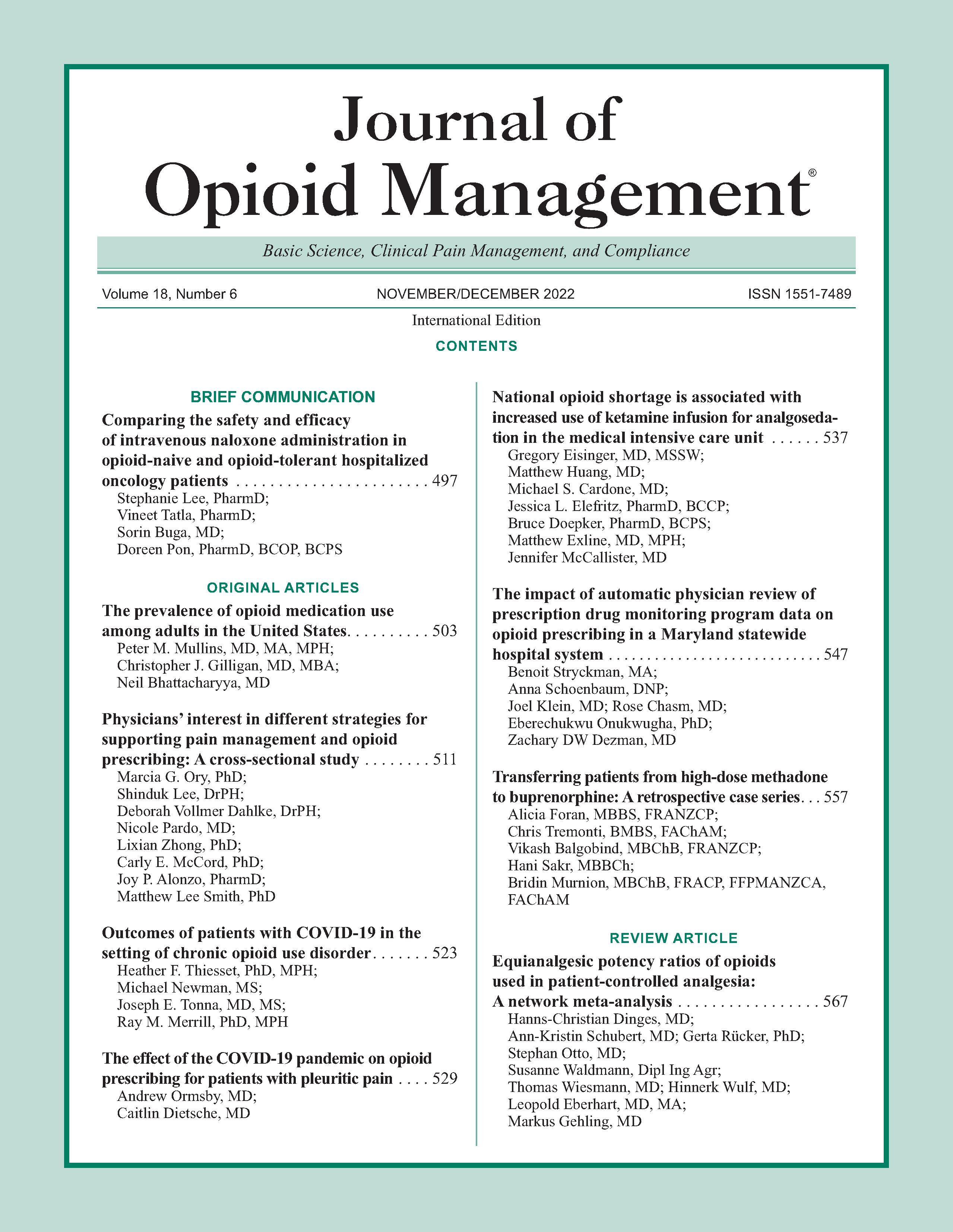The effect of the COVID-19 pandemic on opioid prescribing for patients with pleuritic pain
DOI:
https://doi.org/10.5055/jom.2022.0748Keywords:
opioid prescribing, internal medicine, inpatient, pain management, COVID-19Abstract
Objective: We sought to understand opioid prescribing for COVID-19 positive and negative patients with pleuritic pain during the first wave of the pandemic. We hypothesized that patients without COVID-19 would be prescribed opioids more frequently intrapandemic compared to prepandemic and postulated that COVID-19 patients would be prescribed opioids more frequently and at greater quantity than their peers.
Design: A retrospective observational analysis of electronic health record data.
Setting: A quaternary academic hospital from February through April 2020.
Participants: A total of 1,400 of 3,169 adult inpatient hospitalizations involving pleuritic pain were included.
Main measures: Frequency and average daily dose of opioid prescriptions were analyzed using logistic and linear regression. Opioid prescribing habits were compared pre- and intrapandemic. Hypotheses and primary outcome measures were formulated prior to data collection.
Key results: During the pandemic, COVID-19 patients were 15.77 absolute percentage points less likely to be prescribed opioids compared to patients without COVID-19 (95 percent confidence interval (CI): –8.98 to –22.56 percent). Patients without COVID-19 were equally likely to be prescribed opioids pre- and intrapandemic (95 percent CI: –9.37 to 2.42 percent). Odds ratio of opioid prescription for COVID-19 patients was 0.44 (95 percent CI: 0.08-0.80). Within those given opioids, COVID-19 patients were prescribed 3.0 percent greater morphine milligram equivalents (MMEs) (95 percent CI: 1.07-5.85 percent).
Conclusion: During the first wave of the pandemic, COVID-19 patients with pleuritic pain were prescribed opioids less frequently than patients without COVID-19, while patients without COVID-19 were equally likely to be prescribed opioid pre- and intrapandemic. On the other hand, COVID-19 patients treated with opioids were given greater daily MMEs due to the greater utilization of opioid infusions.
References
Hedegaard H, Miniño AM, Warner M: Drug overdose deaths in the United States, 1999–2018. NCHS Data Brief, no 356. Hyattsville, MD: National Center for Health Statistics. 2020.
Centers for Disease Control: Provisional drug overdose death counts. Vital statistics rapid release. Available at https://www.cdc.gov/nchs/nvss/vsrr/drug-overdose-data.htm. Accessed January 28, 2021.
O’Donnell J, Gladden RM, Mattson CL, et al.: Vital signs: Characteristics of drug overdose deaths involving opioids and stimulants—24 states and the District of Columbia, January–June 2019. MMWR Morb Mortal Wkly Rep. 2020; 69: 1189-1197. DOI: 10.15585/mmwr.mm6935a1external icon.
Ho JY, Hendi AS: Recent trends in life expectancy across high income countries: Retrospective observational study. BMJ. 2018; k2562. DOI: 10.1136/bmj.k2562.
Donohue JM, Kennedy JN, Seymour CW, et al.: Patterns of opioid administration among opioid-naive inpatients and associations with postdischarge opioid use. Ann Intern Med. 2019; 171(2): 81. DOI: 10.7326/m18-2864.
Alexander GC, Stoller KB, Haffajee RL, et al.: An epidemic in the midst of a pandemic: Opioid use disorder and COVID-19. Ann Internal Med. 2020; 173(1): 57-58. DOI: 10.7326/m20-1141.
Duncan RW, Smith KL, Maguire M, et al.: Alternatives to opioids for pain management in the emergency department decreases opioid usage and maintains patient satisfaction. Am J Emerg Med. 2019; 37(1): 38-44. DOI: 10.1016/j.ajem.2018.04.043.
Haley DF, Saitz R: The opioid epidemic during the COVID-19 pandemic. JAMA. 2020; 324(16): 1615-1617. DOI: 10.1001/jama.2020.18543.
Cohen SP, Baber ZB, Buvanendran A, et al.: Pain management best practices from multispecialty organizations during the COVID-19 pandemic and public health crises. Pain Med. 2020; 21(7): 1331-1346. DOI: 10.1093/pm/pnaa127.
Grasselli G, Zangrillo A, Zanella A, et al.: Baseline characteristics and outcomes of 1591 patients infected with SARS-CoV-2 admitted to ICUs of the Lombardy region, Italy. JAMA. 2020; 323(16): 1574-1581. DOI: 10.1001/jama.2020.5394.
Yang X, Yu Y, Xu J, et al.: Clinical course and outcomes of critically ill patients with SARS-CoV-2 pneumonia in Wuhan, China: A single-centered, retrospective, observational study. Lancet. 2020; 8(5): 475-481. DOI: 10.1016/S2213-2600(20)30079-5.
Rees EM, Nightingale ES, Jafari Y, et al.: COVID-19 length of hospital stay: A systematic review and data synthesis. BMC Med. 2020; 18(18). DOI: 10.1186/s12916-020-01726-3.
Ochalek TA, Cumpston KL, Wills BK, et al.: Nonfatal opioid overdoses at an urban emergency department during the COVID-19 pandemic. JAMA. 2020; 324(16): 1673-1674. DOI: 10.1001/jama.2020.17477.
Wainwright JJ, Mikre M, Whitley P, et al.: Analysis of drug test results before and after the US declaration of a national emergency concerning the COVID-19 outbreak. JAMA. 2020; 324(16): 1674-1677. DOI: 10.1001/jama.2020.17694.
Slavova S, Rock P, Bush HM, et al.: Signal of increased opioid overdose during COVID-19 from emergency medical services data. Drug Alcohol Depend. 2020; 214: 108176. DOI: 10.1016/j.drugalcdep.2020.108176.
Opioid Task Force: Physicians’ progress toward ending the nation’s drug overdose and death epidemic. American Medical Association, 2020. Available at www.ama-assn.org/system/files/2020-07/opioid-task-force-progress-report.pdf. Accessed January 28, 2021.
Aitken M: Prescription Opioid Trends in the United States. Measuring and Understanding Progress in the Opioid Crisis. IQVIA Institute, 2020.
Schieber LZ, Guy GP Jr, Seth P, et al.: Variation in adult outpatient opioid prescription dispensing by age and sex—United States, 2008–2018. MMWR Morb Mortal Wkly Rep. 2020; 69: 298-302. DOI: 10.15585/mmwr.mm6911a5.
Center for Preparedness and Response: Increase in fatal drug overdoses across the United States driven by synthetic opioids before and during the COVID-19 pandemic. Center or Disease Control and Prevention. 2020. Available at https://emergency.cdc.gov/han/2020/han00438.asp. Accessed January 28, 2021.
Silva MJ, Kelly Z: The escalation of the opioid epidemic due to COVID-19 and resulting lessons about treatment alternatives. Am J Manag Care. 2020; 26(7). DOI: 10.37765/ajmc.2020.43386.
Published
How to Cite
Issue
Section
License
Copyright 2005-2025, Weston Medical Publishing, LLC and Journal of Opioid Management. All Rights Reserved.











